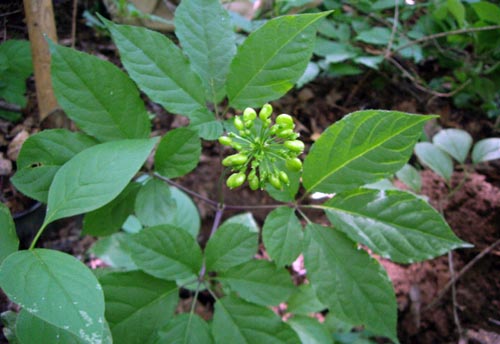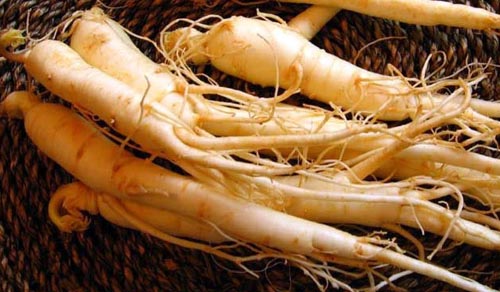The source is from the root of Panax ginseng C. A. Mey. , family Araliceae. The medicinal material is mainly produced in Jilin, Liaoning and Heilongjiang provinces, etc. Among them, the product from Fusong county of Jilin province is the best in quality. The wild ginseng is called "Mountainous Ginseng" while the cultivated one is called " Garden Ginseng" which is usually harvested in the autumn and processed in different ways,dried in the sunlight, steamed, or stir-baked with sugar. According to different processing methods, they are named as. Sunlight-dried ginseng, red ginseng and sugar ginseng respectively. The wild ginseng is dried plainly in the sunlight without any processing, called "dried wild ginseng". Its head is usually removed and it is sliced for use.
Medicinal Properties:
Sweet and slightly bitter in flavor, warm in nature, and attributive to the spleen, lung and heart meridians.
Actions:
Invigorate renal qi, strengthen qi of the spleen and lung, promote production of the body fluids to quench thirst, and calm the mind to promote intelligence.

Application
1. For collapse syndrome due to qi-deficiency manifested as shortness of breath, fatigue, feeble pulseextreme weakness after severe disease, prolonged illness, heavy blood loss or severe vomiting, it is recommended to stew a thick decoction of single ginseng in large amount, which is called Dushen Tang (Decoction); for yang depletion such as qi collapse with sweating and cold extremities, it is used together with Fuzi (Radix Aconiti Lateralis Praeparata), named Shen Fu Tang (Decoction).
2. It is applied for deficiency of the spleen manifested as fatigue, poor appetite, fullness in upper abdomen, or diarrhea and qi deficiency with weakness caused by various factors;it is usually used together with Baizhu ( Rhizoma Atractylodis Macrocephalae ), Fuling Poria), Zhigancao ( Radix Glycyrrhizae, honey-flied), named Sijunzi Tang (Decoction).
3. It is applied for deficiency of lung-qi manifested as shortness of breath, weakness, feeble pulse and spontaneous perspiration, and usually used with Hutaorou ( Caro Juglandis ), Wuweizi ( Fructus Schisandrae ), and Gejie (Gecko), etc., such as Renshen Hutao Tang (Decoction) and Renshen Gejie San (Powder). In the case with chronic cough and bloody sputum due to consumptive disease, it is used together with Ziwan (RadixAsteris), Zhimu (Rhizoma Anemarrhenae) and Ejiao (Colla Corii Asini), etc., such as Ziwan Tang (Decoction).

4. It is applied for diabetes with thirst due to consumption of the body fluids. For febrile disease with consumption of both qi and the body fluids manifested as excessive sweating, shortness of breath, or weak and thin pulse; it is usually used together with Maimendong (Radix Ophiopogonis ), Wuweizi ( Fructus Schisandrae ), such as Shengmai San (Powder). Now its injection is used in clinic for emergency treatment. For diabetes with thirst and frequent micturition, it is used together with Shengdihuang (Radix Rehmanniae ), Xuanshen ( Radix Scrophulariae ), Maimendong ( Radix Ophiopogonis ) and Tianhuafen (Radix Trichosanthis).
5. It is applied for deficiency of qi and blood resulting in failure of the heart to nourish manifested as palpitation, amnesia, insomnia or weakness; and used together with Danggui ( Radix Angelicae Sinensis ), Suanzaoren ( Semen Ziziphi Spinosae ) and Guiyuanrou ( Arillus Longan) because of its action of replenishing heart-qi and soothing the mind, such as Guipi Tang (Decoction).
6. It is applied for deficiency of both qi and blood, or syndrome of blood deficiency. In the case of deficiency of both qi and blood, it is used together with Shudihuang (Radix Rehmanniae Praeparata), such as Liangyi Gao (Soft extract). In the case of blood deficiency, it can be used together with blood tonics such as Danggui (Radix Angelicae Sinensis ) .
In addition, it is also recommended to treat impotence due to kidney deficiency in combination with some yang invigorating tonics. For susceptibility to pathogenic factors from weakness, it is used together with some other herbs to invigorate the body resistance to disease, and to promote healthy qi and eliminate the pathogenic factors.
Usage and Dosage:
5 -10 g is used in decoction. It should be decocted individually on the mild fire, and mixed with decoction of other herbs when drinking. Or the ground powder of 1 -2 g is swallowed. It amounts to 15-30 g that is used in decoction for a syndrome of collapse, which is taken in several times.
Notes:
Contraindicated for the sthenia and heat syndrome without deficiency of healthy qi. It is incompatible with Lilu ( Rhizoma et Radix Veratri ), Wulingzhi (Faeces Trogopterorum ) , and Zaojia ( Fructus Gleditsiae). Turnip and tea should be avoided in the course of treatment in case they affect its tonic effect.

![Diseases, Symptoms, tcm, [tcmwindow.com]](/uploadFile/adImg/2015/4/24/6de633b8-0a7a-4546-868a-02389edf5c65.png)





